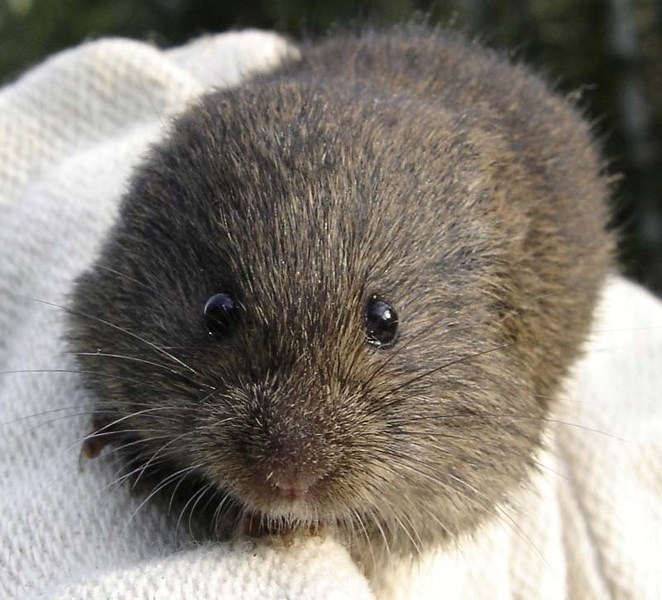Every once in awhile while tromping through knee-deep snow, I’ll spot a mysterious little hole in the surface leading down into the depths.
When I do, it gets me thinking about the warm, yet dark realm my feet are trampling upon, and the curious little meadow voles that dwell within it. I’ve never seen them, but I know they’re there from the tunnels they leave on the lawn come springtime.
Meadow voles are about half the size of a hamster, says Amy Darling, a biologist with Golder Associates who has studied voles in northern Canada. “They’re small, dark, round and fuzzy,” she says, with a little nose, little ears that are almost hidden in their fur, grey bellies and pink or brown feet. “They look a little bit like a teddy bear.” They are the likely the most widespread vole in North America, “and possibly the cutest.”
You’re most likely to find meadow voles in grassy areas around St. Albert, Darling says. Red-backed voles, which have a cinnamon-red stripe on their back, prefer forests. You might mistake a deer mouse for one if it’s moving fast, but the deer mouse will have a much longer tail.
Meadow voles don’t hibernate, notes University of Alberta biologist Stan Boutin, and lack the thick fur or fat reserves needed to survive winter.
Instead, he continues, they live under the snow in the subnivean – the climatic zone between the ground and the snowpack. The snow acts as such a good insulator that this zone can be as warm as 0 C even if it’s -30 C on the surface.
Meadow voles spend the winter huddled together in nests of woven grass, Boutin says, chewing tunnels through the grass – you can see those tunnels on your lawn come spring.
Voles will occasionally come to the surface in the winter if their path is blocked, Darling notes – say, by a ski trail. You’ll often see holes on either side of a ski track where a vole has dashed across.
Voles will keep huddling under the snow late into the spring melt, he notes, and sometimes concentrate under patches of it. He recalls watching predatory crows and raptors having a field day around such a snow patch at the university farm a few years ago. “You’d walk out to that patch and see these little guys running every which way.”
Voles are an irruptive species prone to booms and busts in population, Boutin says. No one’s quite sure what causes these swings, but it’s likely related to food supply and snow cover.
In a good year, you can get up to 300 voles in a single backyard. “These animals are capable of enormous reproductive output,” Boutin explains – about 10 kids every three weeks. That’s good, since most will live for less than a year. “Life is very short and in the fast lane for these guys.”
Meadow vole numbers seem to follow a five-year cycle, Darling notes. As they are food for many predators – particularly owls and weasels – predator populations tend to rise and fall based on the state of the vole.
Voles can leave a labyrinth of tunnels in your grass that looks pretty unsightly, says the Enjoy Centre’s Jim Hole. While you can put wire extruders around your trees to protect them, he suggests ignoring the voles. “When the snow melts, it looks like a horrible problem, but the grass always seems to recover quite quickly.”
While meadow voles are relatively easy to handle, Darling says they don’t make very good pets since they smell bad – possibly a result of their communal living.
I suspect meadow voles have a love-hate relationship with humans. While the huge lawns we create give them territory in which to live, the snowmobiles and boots we use flatten their subnivean homes, forcing them to the surface more often.
That’s why whenever I’m enjoying the deep snow, I’m always a little concerned that I just might be stepping on a vole’s living room.
Meadow vole
Name: <br />Microtus pennsylvanicus.<br /><br />Appearance: <br />Small, round, dark chocolate brown rodent with tiny ears, nose, eyes and tail, plus pink or brown feet. Fits in the palm of your hand.<br /><br />Commonly seen:<br />Usually invisible save for rare moments when it darts above the surface of the snow around dusk or dawn. Otherwise, it hangs around meadows eating grass.<br /><br />Occasionally confused with: <br />Red-backed voles, which have cinnamon-red backs, or deer mice, which have long tails. <br /><br />Fun fact: <br />A 2004 study involving meadow voles suggested that the hormone vasopressin can cause mates to go steady; while normally promiscuous, meadow voles became monogamous when they were engineered to be more sensitive to vasopressin (thought to be released during sex).
Wild St. Albert
Like wildlife? So do we! Every second Wednesday the Gazette profiles a reasonably common wild creature in the St. Albert region. Birds, beasts, bugs, fish … so long as it's alive and kicking, we’ll feature it. <br /><br />Got a creature you’d like to see profiled? Send your suggestions to [email protected].




